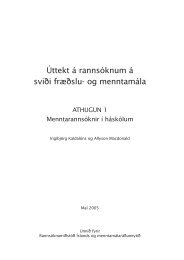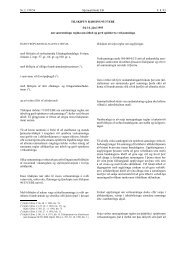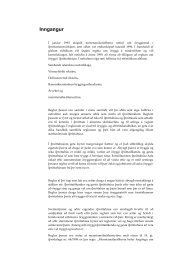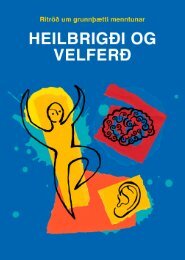Arts and Cultural Education in Iceland : Professor Anne Bamford
Arts and Cultural Education in Iceland : Professor Anne Bamford
Arts and Cultural Education in Iceland : Professor Anne Bamford
Create successful ePaper yourself
Turn your PDF publications into a flip-book with our unique Google optimized e-Paper software.
lot of satisfaction out of the process. They ga<strong>in</strong> confidence. They feel proud of their work when<br />
they show it to others. Children need to be immersed <strong>in</strong> the creative process. The process is the<br />
most important. We need to educate the parents <strong>in</strong> terms of what we are do<strong>in</strong>g <strong>and</strong> why.”<br />
Members of the creative <strong>in</strong>dustries spoke of the importance of arts education for build<strong>in</strong>g<br />
the creative people Icel<strong>and</strong> needs for its future, as the follow<strong>in</strong>g comments suggest:<br />
The arts are many th<strong>in</strong>gs to many people. I th<strong>in</strong>k <strong>in</strong> the future we need more creative pupils with more selfesteem<br />
<strong>and</strong> dignity.<br />
I th<strong>in</strong>k the arts given young people vision. It makes the children more forward th<strong>in</strong>k<strong>in</strong>g <strong>and</strong> responsible <strong>and</strong> they<br />
have more positive self-esteem, identity <strong>and</strong> enhanced social development.<br />
There is also the embedded assumption that arts education provides ‘more’ than just the<br />
simply the knowledge <strong>and</strong> skills of art. Because of this, the overrid<strong>in</strong>g concern is that every child<br />
should experience the arts so they can ga<strong>in</strong> from it, even if they do not become professional<br />
artists. As one of the heads of a music school stated, “The aim is not to produce musicians but to<br />
give everybody the opportunity.” Figure 1.14.1 outl<strong>in</strong>es the ma<strong>in</strong> aims of arts education <strong>in</strong><br />
Icel<strong>and</strong> as suggested <strong>in</strong> the focus groups.<br />
Figure 1.14.1 Aims of arts education <strong>in</strong> Icel<strong>and</strong><br />
Aim identified<br />
Frequency<br />
Culture <strong>and</strong> heritage 4<br />
Quality of life 4<br />
Social development 8<br />
Economic development 1<br />
Intr<strong>in</strong>sic value 5<br />
Practical skills 1<br />
Creativity 5<br />
Intergenerational learn<strong>in</strong>g 2<br />
Personal development 7<br />
Visual literacy 1<br />
Talent development 2<br />
<strong>Education</strong>al development 1<br />
If you exam<strong>in</strong>e the aims offered, the impact of the arts on personal <strong>and</strong> social development<br />
appears to be the most important. These f<strong>in</strong>d<strong>in</strong>gs are replicated <strong>in</strong> the survey f<strong>in</strong>d<strong>in</strong>gs. For<br />
example, Figure 1.14.2 shows that the espoused aim of arts education as suggested by heads of<br />
music schools is <strong>in</strong>creased self-esteem, enjoyment <strong>and</strong> well be<strong>in</strong>g (with 72% of respondents<br />
consider<strong>in</strong>g this to be very important). By comparison, preparation for employment, <strong>and</strong><br />
Icel<strong>and</strong>ic cultural <strong>and</strong> heritage education appear to be of the least importance.<br />
Figure 1.14.2 Importance of different aims for arts education (Music school responses)<br />
49







![Aðalnámskrá tónlistarskóla : rytmÃsk tónlist [Eingöngu á rafrænu formi]](https://img.yumpu.com/50843672/1/184x260/aaalnamskra-tanlistarskala-rytma-sk-tanlist-eingangu-a-rafranu-formi.jpg?quality=85)









